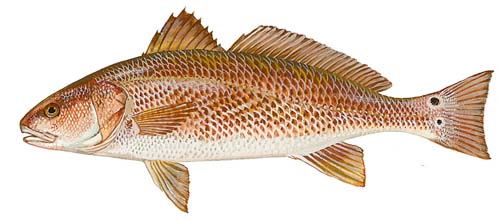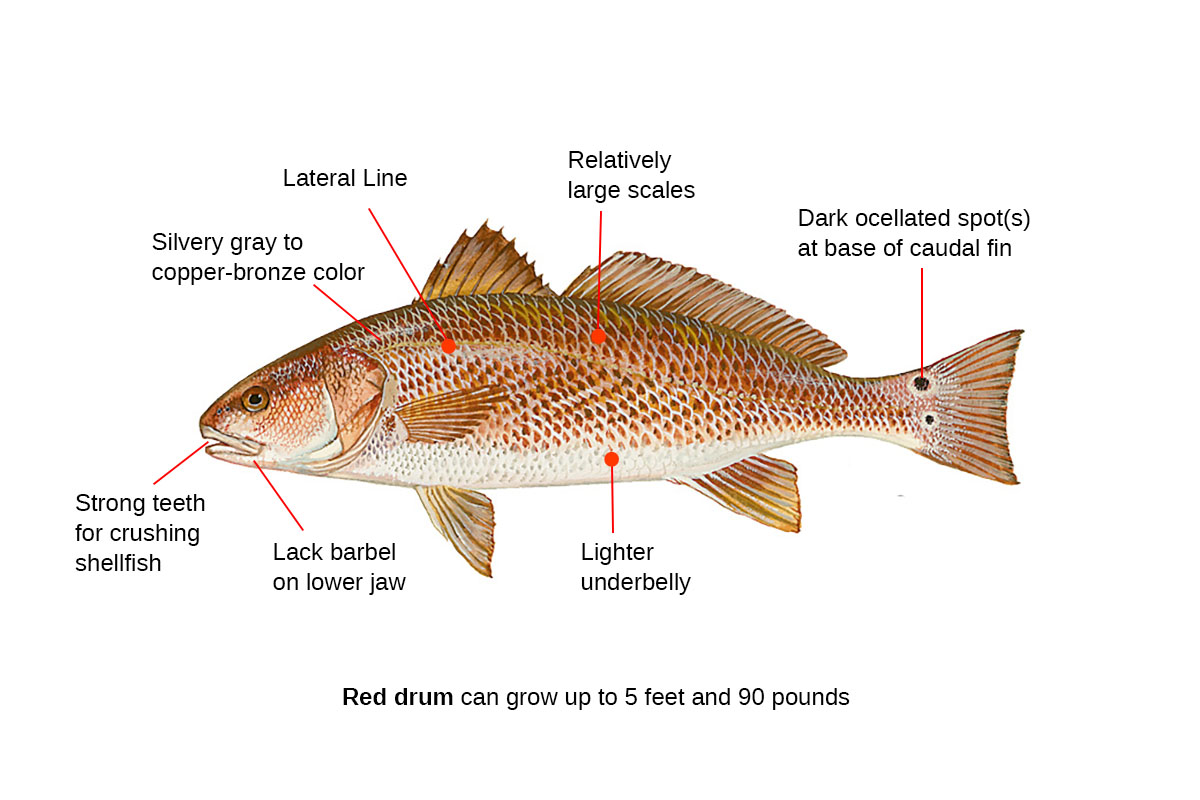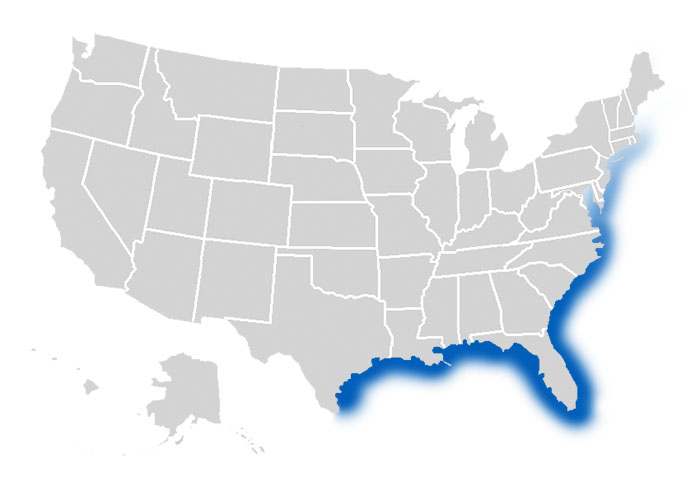Red Drum, commonly known as redfish or channel bass, live in brackish saltwater channels, inlets, bays, marshes, and lagoons along the Gulf coast. Effective methods for catching Red Drum include jigging, drift fishing and surf casting.

Habitat: Bay, Ocean, River
How to identify Red Drum
Red drum have a silvery gray coloring with copper overtones. On both sides of their tail, there is a big black spot, or series of spots, which may also be present on each side of the body. During spawn, male red drum change color.

Similar to other drum species, the red drum has an inferior mouth and a lateral line that extends from the top of the gills to the tip of the caudal fin. Red drum do not have the characteristic chin barbels of some drum species.
Identifying characteristics:
- Silvery gray to copper-bronze color
- Lighter underbelly
- Lateral line
- Dark ocellated spot(s) at base of caudal fin
- Lack barbel on lower jaw
- Relatively large scales
- Strong pharyngeal teeth used for crushing shellfish
Red drum can reach up to 5 feet and 90 pounds, but an average adult red drum is 27 to 36 inches and around 10 pounds.
Where to catch Red Drum
Red drum are found along the Atlantic coast from Maine south to the Florida peninsula and west to the Gulf of Mexico. They congregate in schools in estuarine and nearshore areas, including sounds, bays, lagoons, and marshes, where the water is brackish with sandy or muddy bottoms. The Red drum is a salt-water fish but can also survive in fresh water habitats.

Adolescent red drum are often found in the shallower waters of grass marshes, coastal creeks, estuaries and bays. Adult red drum are found near channels, rivers, inlets, or shell beds, and in the incoming tide along the coast. Both adolescent and adult red drum may congregate around rocky outcroppings and manmade structures. Pilings, jetties, docks and oil rigs are all hotspots of red drum activity.
As the incoming tide from the Atlantic ocean reaches the coastal marshes during warmer summer months, young red drum move into the grasses to feed on grass shrimp, fiddler crabs, mud crabs, and baitfish. As the tide ebbs, they move out of the marsh to the adjacent mudflats. On the mudflats, red drum will collect near structure to reduce their exposure to larger predators.
Adult red drum are found in nearshore coastal waters during warm summer months. As water temperatures along the Atlantic coast cool in late fall, adult red drum move offshore to deeper, warmer waters where they’ll hold for the winter. Fall migration provides an excellent surf fishing opportunity for anglers. In the spring, as waters again warm, red drum will move from deep offshore to shallower nearshore waters.
The following are habitats where you can catch Red Drum:
- Backwater Fishing
- Bays
- Estuaries
- Channel Entrances
- Current Edges
- Dams and Falls
- Drop-offs
- Eddies
- Man-made Structures
- Outside of Bends
- Overhanging Trees and Bushes
- Oyster Bars and Grass Beds
- Riparian Zones
- Ripples, Currents, Swirls and Sprays
- Rock and Boulder Pockets
- Undercut Banks
How to catch Red Drum
Red Drum will eat just about anything from live bait to artificial lures. The best technique for catching Red Drum is casting jigs and working flats, channels, mangroves, and oyster bars using light tackle. Anglers have also had success still fishing on the bottom for these fish. Peak fishing season for Red Drum runs from May through October. They are strong fish and can put up a good fight when caught. A few other effective methods for catching Red Drum drift fishing, surf casting and fly fishing. When surf casting the Fish Finder Rig provides a good presentation for catching red drum. Other effective red drum rigs include the Knocker Rig and Owen Lupton Drum Rig
The following are effective fishing methods and techniques for catching Red Drum:
Best Lures, Bait & Tackle to catch Red Drum
The best live bait for catching red drum includes clams, shrimp, finger mullet, and small crabs. Lures, such as jigs, plugs, spoons, streamer flies, and strip bait also work well.
The following are fishing lures, bait and tackle that can be used to catch Red Drum:



